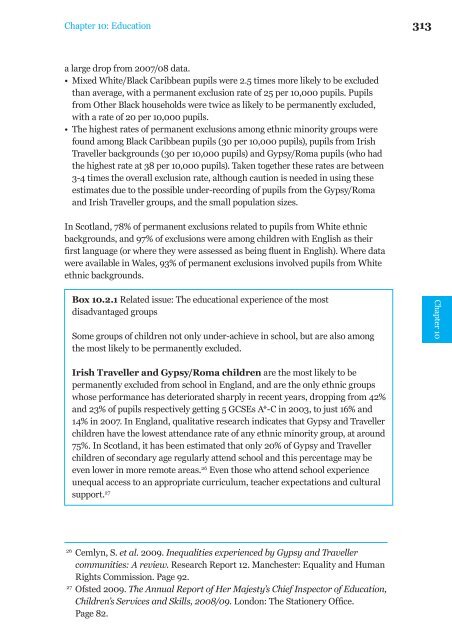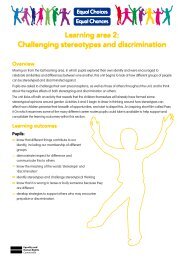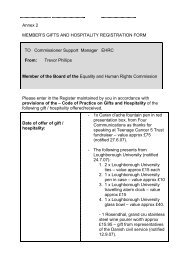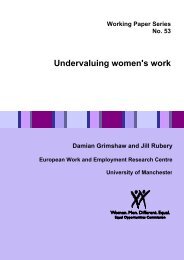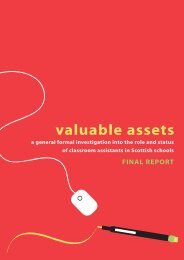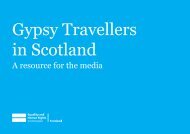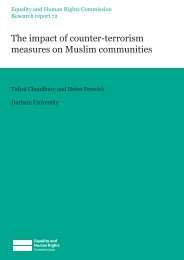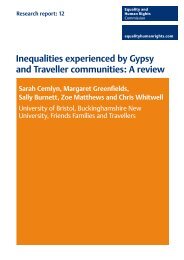Chapter 10: Education - Equality and Human Rights Commission
Chapter 10: Education - Equality and Human Rights Commission
Chapter 10: Education - Equality and Human Rights Commission
Create successful ePaper yourself
Turn your PDF publications into a flip-book with our unique Google optimized e-Paper software.
<strong>Chapter</strong> <strong>10</strong>: <strong>Education</strong> 313<br />
a large drop from 2007/08 data.<br />
• Mixed White/Black Caribbean pupils were 2.5 times more likely to be excluded<br />
than average, with a permanent exclusion rate of 25 per <strong>10</strong>,000 pupils. Pupils<br />
from Other Black households were twice as likely to be permanently excluded,<br />
with a rate of 20 per <strong>10</strong>,000 pupils.<br />
• The highest rates of permanent exclusions among ethnic minority groups were<br />
found among Black Caribbean pupils (30 per <strong>10</strong>,000 pupils), pupils from Irish<br />
Traveller backgrounds (30 per <strong>10</strong>,000 pupils) <strong>and</strong> Gypsy/Roma pupils (who had<br />
the highest rate at 38 per <strong>10</strong>,000 pupils). Taken together these rates are between<br />
3-4 times the overall exclusion rate, although caution is needed in using these<br />
estimates due to the possible under-recording of pupils from the Gypsy/Roma<br />
<strong>and</strong> Irish Traveller groups, <strong>and</strong> the small population sizes.<br />
In Scotl<strong>and</strong>, 78% of permanent exclusions related to pupils from White ethnic<br />
backgrounds, <strong>and</strong> 97% of exclusions were among children with English as their<br />
first language (or where they were assessed as being fluent in English). Where data<br />
were available in Wales, 93% of permanent exclusions involved pupils from White<br />
ethnic backgrounds.<br />
Box <strong>10</strong>.2.1 Related issue: The educational experience of the most<br />
disadvantaged groups<br />
Some groups of children not only under-achieve in school, but are also among<br />
the most likely to be permanently excluded.<br />
<strong>Chapter</strong> <strong>10</strong><br />
Irish Traveller <strong>and</strong> Gypsy/Roma children are the most likely to be<br />
permanently excluded from school in Engl<strong>and</strong>, <strong>and</strong> are the only ethnic groups<br />
whose performance has deteriorated sharply in recent years, dropping from 42%<br />
<strong>and</strong> 23% of pupils respectively getting 5 GCSEs A*-C in 2003, to just 16% <strong>and</strong><br />
14% in 2007. In Engl<strong>and</strong>, qualitative research indicates that Gypsy <strong>and</strong> Traveller<br />
children have the lowest attendance rate of any ethnic minority group, at around<br />
75%. In Scotl<strong>and</strong>, it has been estimated that only 20% of Gypsy <strong>and</strong> Traveller<br />
children of secondary age regularly attend school <strong>and</strong> this percentage may be<br />
even lower in more remote areas. 26 Even those who attend school experience<br />
unequal access to an appropriate curriculum, teacher expectations <strong>and</strong> cultural<br />
support. 27<br />
26<br />
Cemlyn, S. et al. 2009. Inequalities experienced by Gypsy <strong>and</strong> Traveller<br />
communities: A review. Research Report 12. Manchester: <strong>Equality</strong> <strong>and</strong> <strong>Human</strong><br />
<strong>Rights</strong> <strong>Commission</strong>. Page 92.<br />
27<br />
Ofsted 2009. The Annual Report of Her Majesty’s Chief Inspector of <strong>Education</strong>,<br />
Children’s Services <strong>and</strong> Skills, 2008/09. London: The Stationery Office.<br />
Page 82.


